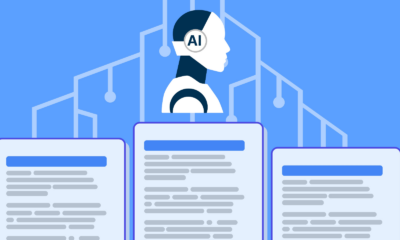MARKETING
Need Content Freelancers? Try This Agency’s Model

A few years ago, after a company layoff, I tried a career as a freelancer. Since my new path wasn’t completely by design, I called myself The Accidental Freelancer.
In the early days, most of the work was writing, and I had regular and one-off gigs. Since then, I established a marketing agency (Attention Retention LLC) and offer services around consulting, content marketing strategy, social media, and product marketing.
Though I’m focused on consulting and still write occasionally, I more often assign writing projects received through inbound requests or my consulting clients to freelancers. Though I’m the only full-time employee, my network of freelancers serves as the agency’s virtual team to satisfy client requests.
Like my freelancing career, I discovered this network by accident. It all started with a tweet:

An unexpected Twitter comment about hiring content freelancers.
After a guest appearance on the Rockstar CMO podcast, someone replied to a tweet promoting the episode: “Hey, are you by any chance hiring marketing professionals?”
I replied, “I’m looking for a freelance writer or two to help with blog posts on marketing-related topics.” Others replied to that with comments like:
- “I’d love to send you a few samples for this position!”
- “Hello, I would love to extend my interest in this. May I know if this requirement is still open?”
- “I’m a content marketer with six years of freelance writing experience. Are you still looking for a freelancer? Would love to be considered!”
At first, I wasn’t quite sure what to do. I hadn’t anticipated so much interest. Truth be told, I didn’t have enough active client projects to distribute to the interested writers; but the opportunity seemed too valuable to overlook. Here’s what I did to create a solid network of freelance writers ready for assignments.
A tweet asking if he was hiring led @dshiao to create a network of #freelancers via @CMIContent. Click To Tweet
HANDPICKED RELATED CONTENT: Content Marketing Basics: How To Start (or Jumpstart) Your Content Marketing Practice
Give every writer a paid gig
I know what it’s like to earn a living from writing. It’s as hard as it seems – you’re not making money unless you’re writing, and all the while, you need to be pitching and hustling for your next assignment.
I didn’t want to ask people for their writing samples or lowball them on a “let’s get to know each other” project. Even though I didn’t know them, I took a leap of faith and hired them for a paid gig.
Every person who asked about a writing gig was given a paid assignment from @dshiao. All of which were good enough to appear on his agency website via @CMIContent. #freelance #writing Click To Tweet
I needed to decide what they would write and thought of two opportunities at my disposal – my agency’s newly launched blog and a Bay Area Content Marketing Meetup of which I was a co-organizer.
I gave a paid assignment to every writer who contacted me on Twitter: Craft a summary of a presentation chosen from the meetup’s playlist. Based on the length and subject of the recording, I gave a target word count, typically in the range of 800 to 1,200 words.
Here was one of the outcomes from Nicole Pyles, who summarized the presentation by marketing executive David Rodnitzky and his new book, Unfair Marketing. It began:
“Online marketing used to be as easy as panning for gold during the California Gold Rush. You didn’t need to put in a whole lot of effort to earn a decent income. However, much like the gold rush, the competition heated up and made it harder to earn a living.”

An example of one freelancer’s paid test post.
The full-length article appeared on my agency blog. (If writers requested, I added a link to their websites or LinkedIn profiles.)
This first paid assignment was essential to helping me build a network of outsourced writing talent. Let’s explore the resulting benefits.
HANDPICKED RELATED CONTENT:
Assess freelance writers’ styles and strengths
All the recap submissions were copy-edited by me and published on the company blog. Editing the writers’ work helped me assess their abilities.
By “ability,” I don’t mean classifying them as an average writer or excellent writer. Instead, I got a feel for the types of assignments where each writer could excel. It was based on my clients’ industries, subject matter, and expectations. When a new writing request comes in from a client, I can pair it with a best-fit writer. These paid gigs were worth their weight in gold.
Don’t assess a #freelance writer as average or excellent. Get specific enough to know what type of assignments they’ll excel at, says @dshiao via @CMIContent. Click To Tweet
Develop an engaged network
Having a network of freelance writers is a win-win scenario: The writers win because the work I send them helps pay the bills. I win because I can fulfill more client requests and assignments. When the writers buy into the process, they’re engaged and are eager to take on more work – as you can see from this (paraphrased) email I received:
“Hi Dennis, I enjoyed working with you in the past. Just checking in to see if you have any new assignments coming up.”
Writers in an engaged network usually respond to new requests quickly and are incentivized to continue delivering quality work.
Always have a freelance team
I recommend having a go-to freelance network, whether you’re at an agency or in a full-time role at a company.
While I’m on the agency side now, I once was a director of content marketing at a B2B software company and didn’t have any direct reports. The network of freelancers I built then was essential to the completion of my projects. Even if you have a full-time team of writers and designers, keep some freelancers on standby in case of employee turnover, illness, or other unexpected events.
I also recommend adopting an always-be-looking mentality – like the always-be-recruiting mindset software engineer managers have, since they commonly face hiring challenges. From time to time, freelance writers in my network take on full-time roles and are no longer available for assignments. So I’m always looking to add to my network.
Take advantage of accidents
I’m probably the happiest I’ve been in my career. I have the independence of running my own business and the excitement of working across different clients and industries. I didn’t have a grand plan for getting here, but I’m thrilled with where I’ve landed.
I fell into freelancing by accident. Next, I discovered a network of freelance writers by accident. In other words: Accidents happen, make the most of them.
Cover image by Joseph Kalinowski/Content Marketing Institute
MARKETING
YouTube Ad Specs, Sizes, and Examples [2024 Update]
![YouTube Ad Specs, Sizes, and Examples [2024 Update] YouTube Ad Specs, Sizes, and Examples](https://articles.entireweb.com/wp-content/uploads/2024/06/YouTube-Ad-Specs-Sizes-and-Examples.jpg)
Introduction
With billions of users each month, YouTube is the world’s second largest search engine and top website for video content. This makes it a great place for advertising. To succeed, advertisers need to follow the correct YouTube ad specifications. These rules help your ad reach more viewers, increasing the chance of gaining new customers and boosting brand awareness.
Types of YouTube Ads
Video Ads
- Description: These play before, during, or after a YouTube video on computers or mobile devices.
- Types:
- In-stream ads: Can be skippable or non-skippable.
- Bumper ads: Non-skippable, short ads that play before, during, or after a video.
Display Ads
- Description: These appear in different spots on YouTube and usually use text or static images.
- Note: YouTube does not support display image ads directly on its app, but these can be targeted to YouTube.com through Google Display Network (GDN).
Companion Banners
- Description: Appears to the right of the YouTube player on desktop.
- Requirement: Must be purchased alongside In-stream ads, Bumper ads, or In-feed ads.
In-feed Ads
- Description: Resemble videos with images, headlines, and text. They link to a public or unlisted YouTube video.
Outstream Ads
- Description: Mobile-only video ads that play outside of YouTube, on websites and apps within the Google video partner network.
Masthead Ads
- Description: Premium, high-visibility banner ads displayed at the top of the YouTube homepage for both desktop and mobile users.
YouTube Ad Specs by Type
Skippable In-stream Video Ads
- Placement: Before, during, or after a YouTube video.
- Resolution:
- Horizontal: 1920 x 1080px
- Vertical: 1080 x 1920px
- Square: 1080 x 1080px
- Aspect Ratio:
- Horizontal: 16:9
- Vertical: 9:16
- Square: 1:1
- Length:
- Awareness: 15-20 seconds
- Consideration: 2-3 minutes
- Action: 15-20 seconds
Non-skippable In-stream Video Ads
- Description: Must be watched completely before the main video.
- Length: 15 seconds (or 20 seconds in certain markets).
- Resolution:
- Horizontal: 1920 x 1080px
- Vertical: 1080 x 1920px
- Square: 1080 x 1080px
- Aspect Ratio:
- Horizontal: 16:9
- Vertical: 9:16
- Square: 1:1
Bumper Ads
- Length: Maximum 6 seconds.
- File Format: MP4, Quicktime, AVI, ASF, Windows Media, or MPEG.
- Resolution:
- Horizontal: 640 x 360px
- Vertical: 480 x 360px
In-feed Ads
- Description: Show alongside YouTube content, like search results or the Home feed.
- Resolution:
- Horizontal: 1920 x 1080px
- Vertical: 1080 x 1920px
- Square: 1080 x 1080px
- Aspect Ratio:
- Horizontal: 16:9
- Square: 1:1
- Length:
- Awareness: 15-20 seconds
- Consideration: 2-3 minutes
- Headline/Description:
- Headline: Up to 2 lines, 40 characters per line
- Description: Up to 2 lines, 35 characters per line
Display Ads
- Description: Static images or animated media that appear on YouTube next to video suggestions, in search results, or on the homepage.
- Image Size: 300×60 pixels.
- File Type: GIF, JPG, PNG.
- File Size: Max 150KB.
- Max Animation Length: 30 seconds.
Outstream Ads
- Description: Mobile-only video ads that appear on websites and apps within the Google video partner network, not on YouTube itself.
- Logo Specs:
- Square: 1:1 (200 x 200px).
- File Type: JPG, GIF, PNG.
- Max Size: 200KB.
Masthead Ads
- Description: High-visibility ads at the top of the YouTube homepage.
- Resolution: 1920 x 1080 or higher.
- File Type: JPG or PNG (without transparency).
Conclusion
YouTube offers a variety of ad formats to reach audiences effectively in 2024. Whether you want to build brand awareness, drive conversions, or target specific demographics, YouTube provides a dynamic platform for your advertising needs. Always follow Google’s advertising policies and the technical ad specs to ensure your ads perform their best. Ready to start using YouTube ads? Contact us today to get started!
MARKETING
Why We Are Always ‘Clicking to Buy’, According to Psychologists

Amazon pillows.
MARKETING
A deeper dive into data, personalization and Copilots

Salesforce launched a collection of new, generative AI-related products at Connections in Chicago this week. They included new Einstein Copilots for marketers and merchants and Einstein Personalization.
To better understand, not only the potential impact of the new products, but the evolving Salesforce architecture, we sat down with Bobby Jania, CMO, Marketing Cloud.
Dig deeper: Salesforce piles on the Einstein Copilots
Salesforce’s evolving architecture
It’s hard to deny that Salesforce likes coming up with new names for platforms and products (what happened to Customer 360?) and this can sometimes make the observer wonder if something is brand new, or old but with a brand new name. In particular, what exactly is Einstein 1 and how is it related to Salesforce Data Cloud?
“Data Cloud is built on the Einstein 1 platform,” Jania explained. “The Einstein 1 platform is our entire Salesforce platform and that includes products like Sales Cloud, Service Cloud — that it includes the original idea of Salesforce not just being in the cloud, but being multi-tenancy.”
Data Cloud — not an acquisition, of course — was built natively on that platform. It was the first product built on Hyperforce, Salesforce’s new cloud infrastructure architecture. “Since Data Cloud was on what we now call the Einstein 1 platform from Day One, it has always natively connected to, and been able to read anything in Sales Cloud, Service Cloud [and so on]. On top of that, we can now bring in, not only structured but unstructured data.”
That’s a significant progression from the position, several years ago, when Salesforce had stitched together a platform around various acquisitions (ExactTarget, for example) that didn’t necessarily talk to each other.
“At times, what we would do is have a kind of behind-the-scenes flow where data from one product could be moved into another product,” said Jania, “but in many of those cases the data would then be in both, whereas now the data is in Data Cloud. Tableau will run natively off Data Cloud; Commerce Cloud, Service Cloud, Marketing Cloud — they’re all going to the same operational customer profile.” They’re not copying the data from Data Cloud, Jania confirmed.
Another thing to know is tit’s possible for Salesforce customers to import their own datasets into Data Cloud. “We wanted to create a federated data model,” said Jania. “If you’re using Snowflake, for example, we more or less virtually sit on your data lake. The value we add is that we will look at all your data and help you form these operational customer profiles.”
Let’s learn more about Einstein Copilot
“Copilot means that I have an assistant with me in the tool where I need to be working that contextually knows what I am trying to do and helps me at every step of the process,” Jania said.
For marketers, this might begin with a campaign brief developed with Copilot’s assistance, the identification of an audience based on the brief, and then the development of email or other content. “What’s really cool is the idea of Einstein Studio where our customers will create actions [for Copilot] that we hadn’t even thought about.”
Here’s a key insight (back to nomenclature). We reported on Copilot for markets, Copilot for merchants, Copilot for shoppers. It turns out, however, that there is just one Copilot, Einstein Copilot, and these are use cases. “There’s just one Copilot, we just add these for a little clarity; we’re going to talk about marketing use cases, about shoppers’ use cases. These are actions for the marketing use cases we built out of the box; you can build your own.”
It’s surely going to take a little time for marketers to learn to work easily with Copilot. “There’s always time for adoption,” Jania agreed. “What is directly connected with this is, this is my ninth Connections and this one has the most hands-on training that I’ve seen since 2014 — and a lot of that is getting people using Data Cloud, using these tools rather than just being given a demo.”
What’s new about Einstein Personalization
Salesforce Einstein has been around since 2016 and many of the use cases seem to have involved personalization in various forms. What’s new?
“Einstein Personalization is a real-time decision engine and it’s going to choose next-best-action, next-best-offer. What is new is that it’s a service now that runs natively on top of Data Cloud.” A lot of real-time decision engines need their own set of data that might actually be a subset of data. “Einstein Personalization is going to look holistically at a customer and recommend a next-best-action that could be natively surfaced in Service Cloud, Sales Cloud or Marketing Cloud.”
Finally, trust
One feature of the presentations at Connections was the reassurance that, although public LLMs like ChatGPT could be selected for application to customer data, none of that data would be retained by the LLMs. Is this just a matter of written agreements? No, not just that, said Jania.
“In the Einstein Trust Layer, all of the data, when it connects to an LLM, runs through our gateway. If there was a prompt that had personally identifiable information — a credit card number, an email address — at a mimum, all that is stripped out. The LLMs do not store the output; we store the output for auditing back in Salesforce. Any output that comes back through our gateway is logged in our system; it runs through a toxicity model; and only at the end do we put PII data back into the answer. There are real pieces beyond a handshake that this data is safe.”
-

 SEARCHENGINES6 days ago
SEARCHENGINES6 days agoBillions Of Google goo.gl URLs To 404 In The Future
-
SEARCHENGINES4 days ago
Daily Search Forum Recap: July 22, 2024
-

 SEARCHENGINES7 days ago
SEARCHENGINES7 days agoGoogle Core Update Coming, Ranking Volatility, Bye Search Notes, AI Overviews, Ads & More
-

 SEO5 days ago
SEO5 days ago11 Copyscape Alternatives To Check Plagiarism
-

 SEO6 days ago
SEO6 days agoGoogle Warns Of Last Chance To Export Notes Search Data
-
SEARCHENGINES3 days ago
Daily Search Forum Recap: July 23, 2024
-

 AFFILIATE MARKETING6 days ago
AFFILIATE MARKETING6 days agoThe Top 5 AI Tools That Can Revolutionize Your Workflow and Boost Productivity
-

 SEO4 days ago
SEO4 days agoSystem Builders – How AI Changes The Work Of SEO















You must be logged in to post a comment Login